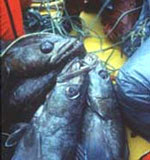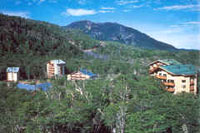Andrew Katkin is the web manager for the National Environmental Trust. He is a member of NET’s team of staffers attending the Convention on the International Trade of Endangered Species.

Monday, 11 Nov 2002
SANTIAGO, Chile
Only a week has passed since the opening ceremonies of the Convention on International Trade in Endangered Species meeting here in Santiago, Chile — but for those of us working the convention, it feels like an eternity. Delegates from all of 160 CITES member countries are here, and since the moment we hit the ground, we’ve been struggling to get their attention. There are proposals to increase or decrease protections for more than 60 species of flora and fauna, and with thousands of NGO representatives working on these issues, it’s easy to get lost in the din.
CITES was developed in the 1970s in response to concerns about the detrimental effect international trade was having on wild animals and plants. In particular, there was a recognition that, with the early stages of globalization and increased international trade, local or regional groups alone could no longer protect their native species.
Every 30 months or so, CITES is convened in a different country. Any member nation can propose protections for any species, although historically, favor has been given to proposals brought by countries where the species is either heavily traded or indigenous. Appendix I protection is for seriously endangered species and it prohibits all commercial trade. Appendix II and Appendix III listings increase export control protections for species threatened by commercial trade. Because of the large number of member countries, a listing with CITES virtually guarantees that trade will be properly regulated and documented worldwide, or, in the case of an Appendix I listing, come to a screeching halt.
I am here with a group of NGOs, including the National Environmental Trust, Greenpeace, and the Antarctica Project, working together with legal fishers from Chile and Australia, to get an Appendix II listing for Patagonian toothfish, known in the U.S. by its market name, Chilean sea bass. The toothfish has been caught by Chilean and Australian fishers working in the waters of the ocean around Antarctica for years, but before the mid-’80s, the fish was almost always discarded as bycatch and tossed, dead, back into the waters from which it was pulled.

Caught by the toothfish.
Photo: Greenpeace.
All of this changed, however, in 1986, when the Chilean government hired a consulting firm to develop a marketing strategy for this unloved fish — previously referred to by the fishers who caught it as the devil fish because of the large amounts of smaller, marketable, fish it ate. Shortly thereafter “Chilean sea bass” was born, and, within a few years, it became one of the hottest dishes at high-end restaurants across America.
Unfortunately for the toothfish, which actually has no relation whatsoever to true sea bass, its popularity has proved to be its downfall. Once avoided by fishers, the so-called devil fish quickly began to be seen as the “white gold” of the sea. Prices for the fish skyrocketed as an international market for it was developed. Catch limits for toothfish are currently set by the Convention on the Conservation of Antarctic Marine Living Resources, a strictly voluntary body with only 24 member countries. While legal fishers carefully record their catches and stay within the limits set by CCAMLR, illegal, pirate fishers routinely flout the voluntary limits. By some estimates, the illegal catch of toothfish in recent years has been two to three times larger than the legal one.
Toothfish is a slow-growing fish that doesn’t reach sexual maturity until it is between 8- and 10-years-old; it can live for up to 80 years and grow to more than 200 pounds. Some marine biologists who study toothfish populations believe that the fish’s population will collapse within five years if we continue to catch it at the current rate, thus making the toothfish one of the shortest-lived food fads in American history. Signs of danger for the toothfish include smaller catches in icy southern waters where large catches were previously the norm, and the taking of smaller and smaller fish, many of which have not yet reached sexual maturity.

That’s where we come in. For the last year, NET has been running the “Take a Pass on Chilean Sea Bass” campaign, organizing chefs and seafood wholesalers across America to reduce demand for the toothfish and educate consumers about the plight of the fish. Already, nearly 1,000 chefs have signed our pledge and agreed to remove toothfish from their menus until its population is protected. Currently, even seafood wholesalers and retailers in the U.S. have no way of knowing whether the toothfish they buy and sell was caught legally by fishers trying to respect catch limits, or by pirate fishers who launder the fish, much like cash is laundered, to obfuscate the fact that it has been poached.
If an Appendix II listing were put in place, the ports that cater to pirate fishers would be forced to properly record the amount of toothfish that they were processing — and wholesalers and restaurants would therefore know that their toothfish was legally caught and that the amount of toothfish being caught was not jeopardizing the long-term survival of the species.
Keep your fingers crossed for us! After a week of press conferences, delegate briefings, and late-night lobbying sessions, we expect the issue to be raised officially at the meeting today and it may be voted on as early as tomorrow. Getting a new species listed on CITES is an uphill battle — it requires a two-thirds majority vote from the delegates. If we are successful, the toothfish would be the first non-mammalian marine species to receive an Appendix II listing. If you want to help, it’s not too late to urge members of the U.S. delegation to support the proposal. Free faxes can be sent via the National Environmental Trust’s online action center.
Monday, 12 Nov 2001
SANTIAGO, Chile
8:30 a.m. — Sometimes at large multi-national meetings like CITES, it’s the translators who have the most power. To date, the translators union has enforced a strict time schedule, ending all meetings by 6 p.m. and, as is the custom in Chile, taking a long lunch break as well. With so many issues on the table here, work is rapidly backing up. We had originally expected our issue — a proposal to list Chilean sea bass (aka Patagonian toothfish) as a CITES Appendix II endangered species — to come to the floor yesterday, but instead the conference spent virtually the entire day focusing on elephants, possibly the most emotional and heated issues facing the conference this year. When the conference broke at 6 p.m., the elephants issue had still to be resolved.
Five African nations — Botswana, Namibia, South Africa, Zambia, and Zimbabwe — have put forward proposals to sell their ivory stockpiles, all of which are supposed to come from elephants that passed away naturally. Kenya and India rejected this proposal and offered their own counter proposal to list every elephant population as CITES Appendix I endangered species, thus prohibiting all international trade in elephants or elephant parts.
South Africa’s ivory collection alone is estimated to be valued at $3 million, so it’s obvious why the country is eager to unload its cache. Conservationists, however, are concerned that the “legal” sale of ivory from government stockpiles in one part of Africa would lead to increased illegal poaching in other parts of the continent. This is hardly a small concern. International demand for ivory, particularly in Asia, is still extremely strong. During 2002, China, Singapore, and Hong Kong recorded their largest ivory seizures in more than a decade. According to the report “Back in Business,” recently released by the Environmental Investigation Agency, in just the last four months, six tons of ivory was seized in Singapore, three tons were seized in Shanghai, and a half-ton was seized in Hong Kong. At least 18 other illegal shipments made it through and are now available on the black market in Japan and China. (Click here to download a copy of the report.)
African elephants are not in such a bad state as they were in 1989, when the CITES listing was originally passed. At that time, the entire population of African elephants was estimated by some to be as low as 300,000, and ivory poachers were depleting those numbers rapidly. Currently, there are more than 600,000 elephants in Africa.
In 1997, CITES allowed the first exception to the ivory sales ban, letting Botswana, Namibia, and Zimbabwe sell 50 tons of raw ivory to Japan. This deal netted these three nations about $5 million, all of which was to be used for elephant conservation programs. South Africa and Zambia are now eager to join these three nations and unload their stockpiles.
The American government initially staked out a neutral position on the ivory sale issue, but appears to be shifting its position to back the sale of at least some of the ivory on the international market. Its spin machine, however, is in full gear and the U.S. delegation is issuing a number of press releases insisting that it would continue to prohibit imports of ivory into the U.S. even if limited ivory trade was approved by CITES. What it fails to mention is that importing ivory into the U.S. is against the law, and the delegation here has no control over that. Only an act of Congress could change the status quo and permit the importation of ivory.
1:00 p.m. — This just in: It appears that the translators union has agreed to work some overtime tonight. An extra evening session, lasting from 7 p.m. to 9:30 p.m., has been added to the schedule and the word around the conference center is that the delegates are going to deal with a lot of issues — including toothfish — during this time.
Also, the delegates have been making their way through the five ivory proposals still on the table. So far, two have passed and the expectation is that the other three will pass sometime this afternoon. The European Union abstained from the vote altogether and the U.S. has refused to identify how it voted on the secret ballot. Word around the convention is that the Kenyan/Indian proposal to place all elephants on Appendix 1 will also be voted on this afternoon — and by all accounts it is expected to fail. All in all, this is not turning in to a very animal-friendly CITES.
Wednesday, 13 Nov 2002
SANTIAGO, Chile
Despite the late night last night, which had delegates — and translators — working till nearly 10 p.m., toothfish still hasn’t been brought to the floor. What that meant for us was a late night with few results. Thankfully, it’s now virtually guaranteed that our issue will be debated today. This is a good thing because our team is on the verge of complete exhaustion, and once the vote is over, we can start to unwind and actually get outside to explore Santiago.

Downtown Santiago.
Despite being cooped up all day yesterday and for much of the past two weeks, some of us have managed to explore the city for at least a few hours. Santiago is usually derided as an intensely polluted city, but so far we’ve only seen a few days of really bad air; for the most part the weather has been spectacular: warm, sunny, and so clear that you can usually see the Andes off in the distance. The one exception to the relatively clean air, bizarrely enough, has been inside the conference center, where smoking is all too prevalent. Right now, sitting in our office at 9:45 a.m., my throat feels like I’ve already inhaled half a pack.
At some international conferences, it’s common for the host government to take pains to clean up the area for its “honored guests.” Before the Asia-Pacific Economic Cooperation Forum summit in Shanghai last year, the Chinese government shut down polluting plants and factories near Shanghai for weeks so that the delegates wouldn’t experience the city’s normally polluted air. Prior to the South Asian Association of Regional Cooperation conference in Kathmandu, Nepal, last December, all of the major roads into the city were repaved and every building along the way was whitewashed. Thankfully, the Chilean government doesn’t seem to have gone out of their way to make Santiago seem like a cleaner, nicer, or wealthier city for CITES, with one sad and fairly gruesome exception.
Sometime late last week, someone decided that the stray dogs wandering the streets near the conference center had to go. We had all just begun to bond with them and had even begun to pick out the ones that we wanted to bring home with us. And then they all disappeared. Late Friday, we were told that they had all been rounded up and fed strychnine. It’s amazing really, thousands of environmental NGO representatives come to a meeting specifically about animal welfare and the host government decides to round up and kill all the stray dogs in the area. This issue hasn’t received a lot of attention, except from the folks at the Humane Society. At one outdoor rally on Friday, a young Chilean held up a poignant sign reading, “Leave the dogs alone. What did they ever do to you?”
Unfortunately, the treatment of the stray dogs hasn’t been the only example of cruelty to animals at this conference. As I mentioned yesterday, this is turning out to be a pretty animal unfriendly meeting of the Convention on International Trade in Endangered Species. Over the course of the day yesterday, three of the five proposals to sell “legally collected” ivory on the international market were approved. The proposals by Zimbabwe and Zambia were rejected, ostensibly because their governments have not demonstrated they can protect their elephant herds. Members of the conference have speculated, however, that Zimbabwe’s proposal, at least, was purposefully defeated as an affront to Zimbabwe’s president, Robert Mugabe, whose policy of land redistribution has sparked intense criticism, particularly among Western nations.
Following these votes, Kenya and India, introduced their proposal to up-list all elephants to Appendix I, thus prohibiting all international trade in elephants or elephant parts, but sensing a lack of support for the proposal, they withdrew it before it reached a vote.

A whale of a whale shark.
Photo: Greenpeace.
Also yesterday, a joint proposal by the Philippines and India to list the whale shark — at 60-feet-long, the world’s largest fish — as an Appendix II endangered species failed to pass by only two votes. Early this morning, a similar proposal by the United Kingdom to offer protections for the basking shark also failed by two votes. These giant fish are hunted almost exclusively for their fins, which are prized in Asia — especially in China and Taiwan — where a single fin can fetch up to $15,000. If listed, the basking would have been the first shark to receive an Appendix I or II listing with CITES.
Tune-in tomorrow to find out if the toothfish meets the same fate as its aquatic brethren or if the delegates choose to protect this overfished, and rapidly endangered, species. Right now, I’m heading out the door to check out Greenpeace’s toothfish protest. The word is that there are going to be several dozen people in toothfish costumes parading in front of the convention center. As with most Greenpeace actions, this one should be fun to watch.
Thursday, 14 Nov 2002
SANTIAGO, Chile
At 5 p.m. yesterday, the CITES conference finally got around to discussing toothfish; however, thanks to back-room negotiations, the issue was dead before it even reached the floor. The U.S. delegation has, apparently, been working all week behind the scenes with Australia (the proponent of the toothfish Appendix II listing) and Chile (the strongest opponent of the resolution) to craft a deal. The end result was that Chile’s proposal, which did little more than codify the status quo, was amended slightly, and Australia’s proposal, which offered genuine protections for toothfish, was introduced and immediately removed.
Obviously, this is a big blow to us — not to mention the poor toothfish! Limited debate was held on the amended Chilean proposal, and a member of our team was recognized and able to state our opposition officially, but by withdrawing their proposal, the Australians insured that no debate would be held on the idea of listing toothfish as an Appendix II species. This is particularly relevant because by addressing the issue of toothfish at CITES, the conference would have taken their first step towards regulating trade in commercial marine species, something that even the CITES Secretariat says is long overdue.
The brokered resolution that passed yesterday provides no additional protections for toothfish, and merely “encourages” CITES parties to participate voluntarily in the pre-existing toothfish trade regime managed by the Commission for the Conservation of Antarctic Marine Living Resources. All nations are already invited by CCAMLR to participate in its trade tracking system — known in CCAMLR circles as the toothfish Catch Documentation Scheme.
There is, however, a small silver lining: CITES members that choose not to participate in CCAMLR’s CDS are encouraged to submit a report on their toothfish fishing and trade activities to the CITES Secretariat. What this means is that CITES is now officially involved, if only as an observer, in the toothfish trade and we have a foot in the door to raise this issue at the next CITES meeting, expected to be held in Bangkok in late 2004.

Osadia.
Thankfully, despite our loss on the floor, we did have one reason to celebrate last night: It was my birthday. Having something worth celebrating after losing on the one issue that we’ve been working on for weeks helped everyone’s morale, and last night’s meal at a hip new Chilean restaurant called Osadia (which means daring) was hands down the best food we’ve had since we got here. I had an amazing spinach malfatti in a red sauce that, it pains me to say, was better than the one I make at home, and halfway through the meal the entire kitchen staff came out — complete with two marionettes in cute little chef hats — and performed a rousing version of “Feliz Cumpleanos”! It was quite a night and a very memorable way to celebrate my birthday.
This morning the CITES delegates are debating the last of the remaining issues, and then things shift gear. Until this point, all debate and voting has taken place in committees. Now, all 160 nations must officially vote on each resolution. Usually, this is little more than a rubber stamp, but some issues remain contentious and the committee vote could be overturned by the full conference of delegates. The Chilean delegation’s toothfish resolution will almost certainly sail through and the Australian resolution will not be discussed at all. Sharks, elephants, and mahogany, however, still remain very controversial, with each of the committee votes having been extraordinarily close. If either side can pick up an extra vote or two, it will push to have issues reopened and to have a new round of voting. Conservationists still have great hopes for winning on the basking shark and whale shark proposals, each of which lost by only two votes, and the timber industry will almost certainly make a last minute effort to defeat the resolution that places all mahogany on CITES Appendix II. The mahogany issue has been brought to CITES for each of the last four meetings and finally passed this year by just two votes.
Tomorrow, I’ll let you know if any of these disputed issues managed to flip-flop during the final stage of debate.
Friday, 15 Nov 2002
SANTIAGO, Chile
9 a.m. — The 12th Conference of Parties to the Convention on International Trade in Endangered Species is ending not with a bang, but with a whimper. Befitting the fact that the final plenary session of CITES does little more than rubber stamp the decisions made originally in the committee meetings, most NGOs have already packed up and headed home. By the time I had finished writing yesterday’s post and left the office for lunch, the booths surrounding our office had already been vacated and the temporary partitions that had formed the physical geography of our lives for the last two weeks were being yanked down.
It was really quite odd: We worked almost non-stop until late Wednesday night when the toothfish resolution was finally debated, and by the next morning, the pace, not just for us, but for the whole conference, had dramatically changed. The conference is still going on, but our work is done and the finale for us has been rather anticlimactic. There is at least one silver lining, however: With the conference center rapidly emptying, the number of people standing around our offices and smoking cigarettes has dramatically decreased. We’re all enjoying the clean indoor air this morning.
Even though most NGOs have already left town, there are still some important decisions being made here at CITES. The plenary meeting is being lobbied aggressively on a few key issues and has already agreed to change a few close and controversial votes. Some votes are being changed because several nations have only just recently managed to register and receive their official credentials for the conference.

Bottlenose dolphins.
NOAA.
Among the decisions that have been altered is Georgia’s proposal to list the Black Sea bottlenose dolphin under CITES. Originally, Georgia had pushed for the strongest protection CITES offers — an Appendix I listing — but, in what could prove to be either a dangerous or useful tactic for conservationists, the country has agreed to accept an Appendix II listing with a zero-trade quota. This means that countries (currently Russian and the Ukraine) capturing bottlenose dolphins from the Black Sea will not be able to issue export permits to sell them on the international market.
Bottlenose dolphins are in high demand from circuses, amusement parks, dolphinariums, and marine parks for their playful acrobatics and receptivity to training. Russia, the world’s leading exporter of these dolphins — which can fetch up to $30,000 on the open market and are sometimes traded online — led the opposition to a ban, saying that its studies show the population is thriving and unharmed by trade. Environmentalists counter that the species takes nearly as long as humans to reach sexual maturity and that increased trading in recent years, combined with pollution in the Black Sea, is seriously undermining the population. The original attempt to place the bottlenose dolphins on CITES Appendix I lost by a wide margin, but the Appendix II listing passed yesterday by 83 to 16.

Beautiful Bryde’s.
Greenpeace.
There’s also good news for whale lovers: Despite furious lobbying, the Japanese delegation failed yesterday in their final attempt to downlist minke and Bryde’s whales from CITES Appendix I, which bans all cross-border trade. The committee votes on these two whale species were extraordinarily close and many environmentalists here feared that Japan might successfully swap — or possibly even buy — the votes necessary to begin trading the whales again.
Other victories for the conservationists here at CITES include the listing of all 32 species of seahorses on Appendix II, thus restricting its trade. Seahorses, depending on the region of the world in which they are caught, are used primarily in traditional medicine or sold as kitschy trinkets from a beach vacation. The species faces extinction across the globe with catches in some areas already down by 95 percent.
Also, on Thursday, CITES voted to provide safeguards to protect bears from the gruesome practice under which they are kept in tiny cages and milked for their bile, a greenish-brown digestive fluid secreted by the liver and stored in the gallbladder. The bile is prized in traditional Chinese medicine for treating liver disease and headaches; it is used also in a growing number of luxury cosmetics. Chinese “bear farms” are notorious for the poor conditions in which the animals live, and for the fact that the bile is drained by placing pipes into wounds that are purposefully kept open throughout the life of the animal.
11 a.m. — Wow! Great news! We’ve just received word that the proposals to list basking sharks and whale sharks on CITES Appendix II, each of which failed by only two votes in committee, were accepted in the plenary session. The fins — and only the fins — from the sharks are prized in places like China and Taiwan, where shark fin soup is considered a delicacy and the giant fins can fetch upwards of $15,000 apiece. Since the loss in committee, the conservation community has been furiously lobbying the delegates. This is by all counts a major victory for the environmental movement.

Termas de Chillan.
Okay, we’re about to shut down our office and head out for some last-minute shopping, so I have to wrap this up. Although I hate to admit it, I’m a little jealous of the folks who are heading home tonight. The thought of sleeping in my own bed and eating a good meal back in Washington, D.C. is awfully appealing. That said, I’m happy that I’m sticking around to explore Chile next week. Tomorrow, several of my colleagues and I are heading up into the high Andes across the border into Argentina for a few hours of trekking. After that, we’ll drive south to a famous Chilean spa (Termas de Chillan) for a few days of much needed R&R, then we’ll travel back up the coast, stopping along the way at a few beach towns. We’ll end our vacation at the port city of Valparaiso, just a few hours to the west of here. It should be an amazing vacation and I’m really looking forward to having more time to explore this diverse country.
Well, thanks to everyone who’s made it through my posts this week. Its been a great experience writing for you and I hope my dispatches from CITES have provided an interesting window on the world of multi-national conservation efforts. If you have any questions feel free to drop me a note at akatkin@environet.org; I’d love to hear from any Grist readers out there!

